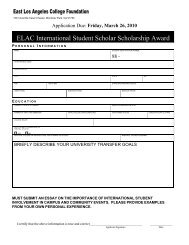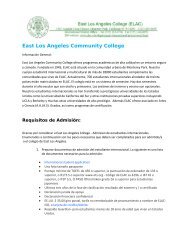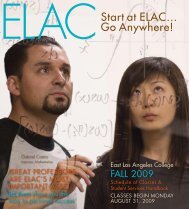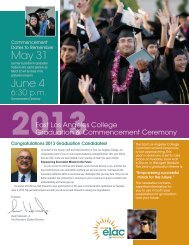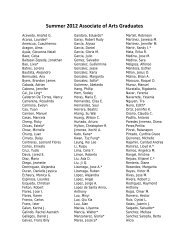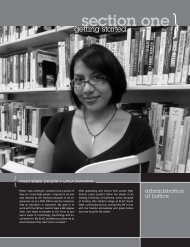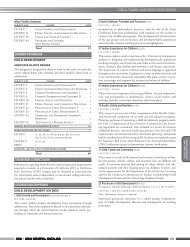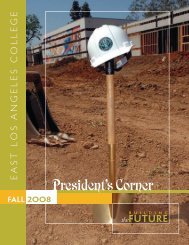ELAC President's Corner Spring 2007 - East Los Angeles College
ELAC President's Corner Spring 2007 - East Los Angeles College
ELAC President's Corner Spring 2007 - East Los Angeles College
You also want an ePaper? Increase the reach of your titles
YUMPU automatically turns print PDFs into web optimized ePapers that Google loves.
<strong>East</strong> <strong>Los</strong> <strong>Angeles</strong> <strong>College</strong>President’s <strong>Corner</strong>SPRING <strong>2007</strong>Al Cone, <strong>ELAC</strong> athletic director and former baseball coach, addressesthe audience during the ribbon-cutting ceremony as Coach James Hines,left, Richard Anderson, director of public affairs, Interim PresidentRobert G. Isomoto, and former assistant coach Jack Furin look on.Play Ball!Celebrating the completion of modernization projectsto improve the baseball field, <strong>East</strong> <strong>Los</strong> <strong>Angeles</strong> <strong>College</strong>commemorated the event with a ribbon-cuttingceremony Jan. 20. <strong>ELAC</strong> Interim President Robert G.Isomoto was joined by college staff, former coaches andalumni in the ceremony. Immediately following the ceremony,<strong>ELAC</strong> hosted an alumni baseball game, utilizingthe new amenities of the field.The newly modernized facility, which was fundedby the <strong>Los</strong> <strong>Angeles</strong> Community <strong>College</strong> District’s $2.2billion Propositions A/AA Bond Programs, includes:dugouts, a barrier fence, a state-of-the-art trainingcenter that houses fully equipped team dressingrooms, a rehabilitation training room designed to preventand treat injuries, an announcer’s booth, a coach’soffice; a snack bar and public restrooms.“We want to be good neighbors so we installed 75-foot fences to protect street traffic, our Child DevelopmentCenter, and homes located on Bleakwood Avenue,”Isomoto said.The improved baseball field and new facilities will alsobe a huge attraction for student-athletes that are beingrecruited by <strong>ELAC</strong> Coach James Hines.“This new field will be a way to encourage talentedyoung players to continue their education and play baseballhere at <strong>East</strong> L.A. <strong>College</strong>,” Hines said.<strong>ELAC</strong>’s <strong>2007</strong> baseball season opened the followingweekend and the modernized field was promptly putto good use as the Huskies played four games in threedays, winning all four of them. Under Hines, <strong>ELAC</strong> haswon South Coast Conference titles in 2000, 2004 and2005. He has guided teams to the state playoffs fourtimes and to the State finals in 2000.<strong>ELAC</strong> has had a number of players that either transferredto four-year colleges and universities, or have goneon to sign with major league teams, and this year is no exception.Outfielder Eric Stephens has already signed a letterof intent with Cal State Fullerton. Stephens, who attendedMonrovia High School, was named to the All-South CoastConference and All Southern California regional team in2006. He will transfer to Fullerton after the <strong>2007</strong> season.As noted, the <strong>Los</strong> <strong>Angeles</strong> Community <strong>College</strong> District’sconstruction and modernization projects receivefunding from Propositions A and AA, two bond measuresoverwhelmingly approved by <strong>Los</strong> <strong>Angeles</strong> Votersin 2001 and 2003. <strong>ELAC</strong> projects nearing groundbreakinginclude the Fine and Performing Arts Complex tobe located on the eastern end of the campus and a newmulti-level parking structure next to the E-1 building.For more information, visit the construction program’swebsite at www.PropositionA.org nFormer teammates Mike Espinoza, left, andEthan Katz were among the players that turnedout for <strong>ELAC</strong>’s annual alumni game that tookplace after the ceremony.EStudent PhotographersExplore Urban Landscapes<strong>ELAC</strong> student photographer Marco Martinez roamedthe hills surrounding the <strong>Los</strong> <strong>Angeles</strong> Civic Center shootingnight scenes that transformed downtown into a fantasyof glowing lights and shadows. Norma Cardenas soughtout religious lawn-art featuring statues of the Virgin andsaints, flowers and candles. Manny Campos explored OlveraStreet and neighborhoods surrounding old <strong>Los</strong> <strong>Angeles</strong>in search of examples of how nature continues to assertitself in the city.They were among 10 <strong>East</strong> <strong>Los</strong> <strong>Angeles</strong> <strong>College</strong> photographystudents who participated in the Getty Project inspiredby their recent show, “Where We Live: Photographsof America from the Berman Collection.” <strong>College</strong>of the Canyons, <strong>Los</strong> <strong>Angeles</strong> Valley and Santa Monicacolleges were also invited to send teams of 10 studentswho were paired with nationally-known photographersfeatured in the exhibit.The goal of the project is to capture “where we live” usingstudent photographers working with the professionalsto guide them. Camillo Jose Vergara, a featured photographerin the Getty exhibition, worked with the <strong>ELAC</strong> students.Vergara was trained as a sociologist and started takingphotographs to document his studies and observations.He introduced students to the history of urban landscapein photography and accompanied them on a day long photoshoot. The Getty Project is designed to inspire communitycollege students to photograph physical changes that reflectthe social evolution of their neighborhoods.The Getty’s Photographs Council will pay to frame thebest student photographs and arrange a traveling exhibitionat each of the participating colleges. The traveling showwill be featured in <strong>ELAC</strong>’s Vincent Price Gallery and Museumin fall <strong>2007</strong>.Campos is a commercial photographer who enrolls inevening photo classes to keep his creative juices flowing.“Participating in the Getty project changed the way I lookChristopher Velasco, Hyperion PlantMarco Martinez, “L.A. at Nightat life,” Campos says. “I realized how to use everyday thingslike grass growing through the concrete in a sidewalk todemonstrate that nature always fights back. Even thoughwe try to subdue nature with concrete and asphalt, grass alwaysmanages to survive – even in the city.”Martinez also works during the day and is employed bythe city of South Gate taking photographs of various engineeringprojects. He began studying photography while attendingSouth Gate High School. His teacher Dean Larsonurged him to enroll at <strong>ELAC</strong> and major in photographyto build his skills. Participating in the Getty project madeMartinez more observant and now he views cityscapeswith an artist’s eye.“I became fascinated with the effects of light on buildingsand streets,” Martinez said. “A day light photographuses a 10-second exposure and movement is minimal. I hadto use 20-to-30-second exposures in the dark and movementbecomes a design element in my photographs.”Marilyn Montufar also began studying photographywhile a student at Schurr High School in Montebello. Shehopes to be a fine art photographer and plans to transfer toa university program after graduating from <strong>ELAC</strong>.“I photographed abandoned buildings, street details andurban landscapes that describe poverty for the Getty Project,”Montufar said. “I learned that the title of a photographcan change a person’s perception of the image.”Mei Valenzuela, photography instructor and fine artists,taught an independent study course for the <strong>ELAC</strong> students participatingin the Getty Project. “We were confident our studentshave the technical skills to back up their ideas. Working withfine art photographers made them realize they can comment onsocial issues using their photographs,” she said.Other students who participated in the Getty Projectare: Joanne Aartman, Tommy Blanco, Jimmy Centeno,Maria Gonzalez, Michael Quinn and Chris Velasco.The students photographed <strong>East</strong> <strong>Los</strong> <strong>Angeles</strong> from the civiccenter to Alhambra, Highland Park, Monterey Park, SouthGate and El Sereno. Most live in the neighborhoods theyphotographed, and all submitted three photographs thatwill be juried for the final show.“The Getty Project treats photography as an art-formas well as social commentary,” said Velasco, speaking ofhis experience. “I started as a painter and transitionedto photography, but now I realize I can combine the twodisciplines” n



